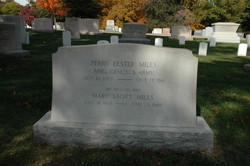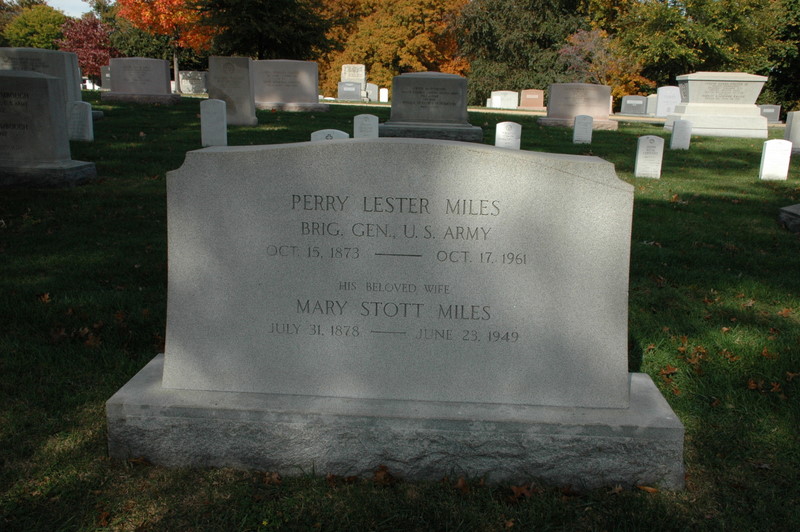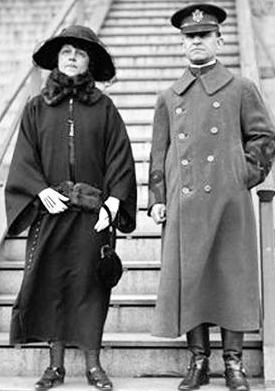Brigadier General.
He was the son of Judge James Alexander Miles and Mary Esther Longwell Miles.
On December 28, 1921 as Perry L. Miles, he married Mary Latta Stott at the Church of the Covenant in the District of Columbia.
They had no children.
After graduation in 1895, he was assigned to the 14th Infantry at Vancouver Barracks in Washington State. In April 1898 the war with Spain began and Companies A, C. D, E and F of the 14th Infantry were ordered to San Francisco to board ship to the Philippine Islands. Then, a Second Lieutenant he was in command of Company E of the 14th. The first stop was in Honolulu, Hawaii to replenish the ship's coal. Next, there was a delay at Guam, the largest of what were then the Spanish Mariana Islands. The troops arrived in Manila Bay at the end of June 1898 and the 14th Infantry was quartered at the former Spanish Naval Station at Cavite, which was on the south shore of the bay. On August 13, 1898 the south side of the city of Manila was attacked and the Spaniards surrendered. For the next two years the Philippine resistance and the United States troops engaged in a struggle for control of the Philippines. On February 5, 1899 his unit was ordered to capture a blockhouse on the south side of the city which was occupied by the insurgents. He charged across 200 years with five or six men and the blockhouse was captured. Years later when decorations were implemented in the United States Army he was awarded the Distinguished Service Cross for extraordinary heroism in action near Manila, Philippine Islands, 5 February 1899. Next, he participated in the Santa Cruz expedition to Laguna de Bay which was located to the east of Manila and in the action at Zapote River which was south of Manila. In October 1899, at the age of 26 years, he was appointed Captain of Volunteers in the Quartermaster Department. He served for two years as Quartermaster on the United States Army Transports Warren and Sheridan and made trips of about 26 days between Manila and San Francisco. He was on transport duty until December 1901. He rejoined his regiment and took command of Company M at Fort Niagara, New York. In February 1903, the 14th Infantry returned to the Philippines for a two year tour at the Island of Samar. In spring 1905 the 14th returned to Vancouver Barracks. For a short time he was the youngest captain in the Army. After two years he was sent to Girard College in Philadelphia as the Professor of Military Science & Tactics (PMS&T). He was able to take some law classes at the University of Pennsylvania Law School. In 1914, he accompanied the regiment to the Mexican Border. In 1916, he graduated from the Army School of the Line as a Distinguished Graduate. He later became the Inspector of the National Guard of Wisconsin and spent time in Ohio selecting recruits for the 90 day training for commissions in the National Army in World War I. In fall 1917 as a colonel in the National Army he was selected to raise and command a regiment of Negro draftees at Camp Jackson in Columbia, South Carolina. After six months the regiment which became the 371st Infantry was sent to France. He was awarded the Distinguished Service Medal, the citation reading: for exceptionally meritorious and distinguished service as commander of the 371st Infantry, which during the active operations was attached to the French forces. He also received the French Croix de Guerre with Palm, and the French Legion of Honor (Officier). After his return to the United States and now a permanent Colonel he attended the Army Staff College, graduating in 1920 and then the Army War College in 1921. From 1928 to 1932 he was PMS&T at UCLA in Los Angeles. In 1932 he was promoted to Brigadier General and was assigned to Washington, District of Columbia until 1936 as commander of the 16th Infantry Brigade and the military District of Washington. When 22,000 veterans of the first World War came to Washington in 1932 demanding a special bonus for war services he used a battalion of Infantry, a squadron of Cavalry and two tanks to evict the veterans from their camp on Pennsylvania Avenue near the Capitol. No shots were fired, but tear gas was used and no serious injuries resulted. In 1936, he left Washington and took command of the 2nd Brigade (1st Division) and the Northern Division of the Civilian Conservation Corps at Fort Ontario in New York. In 1937 he retired from active duty at the age of 64 years. After retirement he resided in Staunton, Virginia. During World War II he was chairman of the Shenandoah Valley Regional Defense Council, the Staunton and Augusta County War Finance Committee and the Staunton Salvage Committee. He began writing his memories which became the book, Fallen Leaves. He was married to Mary Latta Stott of the District of Columbia. They had no children. In addition to the DSC, DSM and French decorations, he was awarded the Silver Star and Purple Heart and the Spanish War, Philippine Campaign and Victory Medals. He was a member of the American Legion, the Military Order of the World War, Spanish-American War Veterans and the Military Order of the Carabao.
Source: United States Military Academy Association of Graduates memorial.
Brigadier General.
He was the son of Judge James Alexander Miles and Mary Esther Longwell Miles.
On December 28, 1921 as Perry L. Miles, he married Mary Latta Stott at the Church of the Covenant in the District of Columbia.
They had no children.
After graduation in 1895, he was assigned to the 14th Infantry at Vancouver Barracks in Washington State. In April 1898 the war with Spain began and Companies A, C. D, E and F of the 14th Infantry were ordered to San Francisco to board ship to the Philippine Islands. Then, a Second Lieutenant he was in command of Company E of the 14th. The first stop was in Honolulu, Hawaii to replenish the ship's coal. Next, there was a delay at Guam, the largest of what were then the Spanish Mariana Islands. The troops arrived in Manila Bay at the end of June 1898 and the 14th Infantry was quartered at the former Spanish Naval Station at Cavite, which was on the south shore of the bay. On August 13, 1898 the south side of the city of Manila was attacked and the Spaniards surrendered. For the next two years the Philippine resistance and the United States troops engaged in a struggle for control of the Philippines. On February 5, 1899 his unit was ordered to capture a blockhouse on the south side of the city which was occupied by the insurgents. He charged across 200 years with five or six men and the blockhouse was captured. Years later when decorations were implemented in the United States Army he was awarded the Distinguished Service Cross for extraordinary heroism in action near Manila, Philippine Islands, 5 February 1899. Next, he participated in the Santa Cruz expedition to Laguna de Bay which was located to the east of Manila and in the action at Zapote River which was south of Manila. In October 1899, at the age of 26 years, he was appointed Captain of Volunteers in the Quartermaster Department. He served for two years as Quartermaster on the United States Army Transports Warren and Sheridan and made trips of about 26 days between Manila and San Francisco. He was on transport duty until December 1901. He rejoined his regiment and took command of Company M at Fort Niagara, New York. In February 1903, the 14th Infantry returned to the Philippines for a two year tour at the Island of Samar. In spring 1905 the 14th returned to Vancouver Barracks. For a short time he was the youngest captain in the Army. After two years he was sent to Girard College in Philadelphia as the Professor of Military Science & Tactics (PMS&T). He was able to take some law classes at the University of Pennsylvania Law School. In 1914, he accompanied the regiment to the Mexican Border. In 1916, he graduated from the Army School of the Line as a Distinguished Graduate. He later became the Inspector of the National Guard of Wisconsin and spent time in Ohio selecting recruits for the 90 day training for commissions in the National Army in World War I. In fall 1917 as a colonel in the National Army he was selected to raise and command a regiment of Negro draftees at Camp Jackson in Columbia, South Carolina. After six months the regiment which became the 371st Infantry was sent to France. He was awarded the Distinguished Service Medal, the citation reading: for exceptionally meritorious and distinguished service as commander of the 371st Infantry, which during the active operations was attached to the French forces. He also received the French Croix de Guerre with Palm, and the French Legion of Honor (Officier). After his return to the United States and now a permanent Colonel he attended the Army Staff College, graduating in 1920 and then the Army War College in 1921. From 1928 to 1932 he was PMS&T at UCLA in Los Angeles. In 1932 he was promoted to Brigadier General and was assigned to Washington, District of Columbia until 1936 as commander of the 16th Infantry Brigade and the military District of Washington. When 22,000 veterans of the first World War came to Washington in 1932 demanding a special bonus for war services he used a battalion of Infantry, a squadron of Cavalry and two tanks to evict the veterans from their camp on Pennsylvania Avenue near the Capitol. No shots were fired, but tear gas was used and no serious injuries resulted. In 1936, he left Washington and took command of the 2nd Brigade (1st Division) and the Northern Division of the Civilian Conservation Corps at Fort Ontario in New York. In 1937 he retired from active duty at the age of 64 years. After retirement he resided in Staunton, Virginia. During World War II he was chairman of the Shenandoah Valley Regional Defense Council, the Staunton and Augusta County War Finance Committee and the Staunton Salvage Committee. He began writing his memories which became the book, Fallen Leaves. He was married to Mary Latta Stott of the District of Columbia. They had no children. In addition to the DSC, DSM and French decorations, he was awarded the Silver Star and Purple Heart and the Spanish War, Philippine Campaign and Victory Medals. He was a member of the American Legion, the Military Order of the World War, Spanish-American War Veterans and the Military Order of the Carabao.
Source: United States Military Academy Association of Graduates memorial.
Family Members
Sponsored by Ancestry
Advertisement
Advertisement










